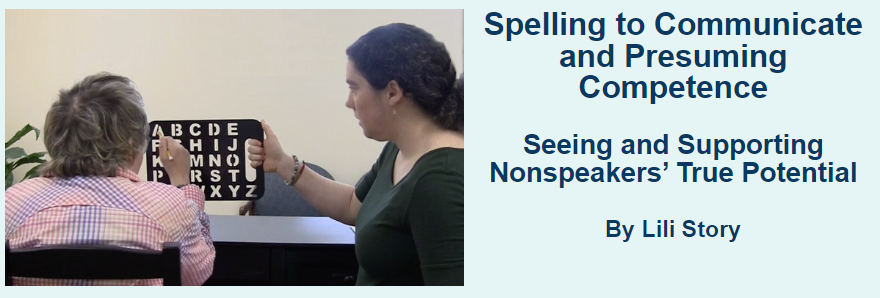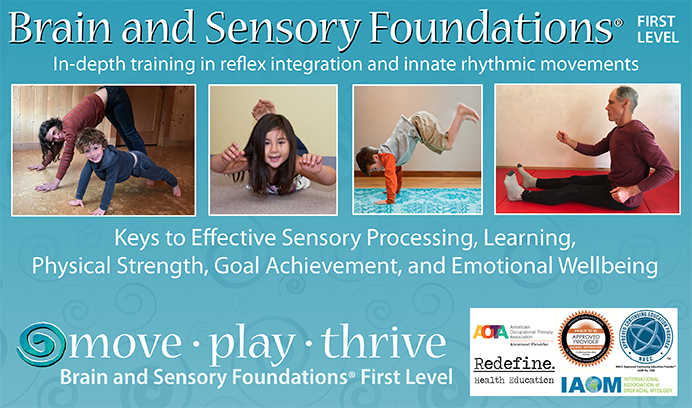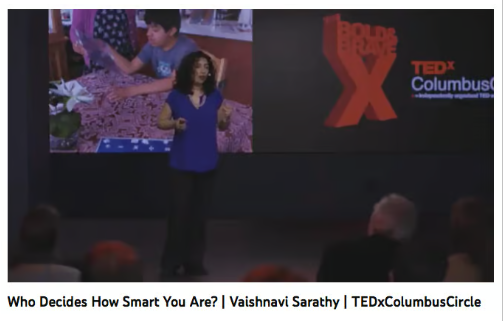Greetings,
Have you ever heard the terms "nonverbal" and "intellectual disability" used to describe certain autistic individuals and other nonspeakers?
It turns out that most of us got it wrong. Very wrong.
Individuals who cannot speak are telling us that they learn, think, and feel just like all human beings. They may appear as if they cannot understand what is going on around them. They may not be able to physically follow directions, but they do understand them, and they want to communicate. These individuals are capable, eloquent, and intelligent. They are just not able to communicate or move in a way that shows their understanding and intelligence.
Until recently.
Pioneers like Elizabeth Vosseller, and others like her, have developed brilliant methods for nonspeakers to communicate through spelling. The Spelling 2 Communicate (S2C) method, developed by Vosseller, was featured in the award winning documentary film, SPELLERS. In SPELLERS, and from books like Underestimated, by JB Handley and Jamison Handley, we learn that there are thousands of nonspeaking individuals who are now able to communicate via spelling.
Spellers are turning upside down what we thought we knew about autism and so-called intellectual disability.
Spellers young and old are all communicating the same thing: They do not have cognitive delays, rather they have severe sensory-motor challenges. They understand and learn, but they lack the motor skills to use standard methods of communication. Because of this, S2C practitioners stress the importance of "presuming competence." (More on that below).
It is not our fault that most of us got this so wrong for so long. It is how we were taught, over decades. Even Dr. Blomberg spoke of some autistics being intellectually disabled. Unfortunately I believed him at the time, even though I remember feeling uncomfortable with this. But now that we know we got it wrong, we need to humbly learn from our mistakes and correct them.
It is time to throw out our old ideas and old labels.
It is so exciting to be a part of the S2C/Spellers movement which I have learned much about from Lili Story, our daughter, who is a new S2C practitioner. Lili shares more about S2C below. We can all celebrate how this wonderful program helps release so many individuals from their prisons of silence.
For learning more about presuming competence, see S2C Practitioner Lili Story's article below and watch the excellent TEDx talk by my friend Vaish Sarathy--it is a mind-blowing must see. I promise you will never forget it.
It is important to point out the benefits of neurodevelopmental movements from the Brain and Sensory Foundations program because we are seeing that when spellers get access to innate movements they make huge leaps in progress with their spelling skills. The neurodevelopmental movements can help with gross motor and fine motor skills, self regulation, visual motor skills, calming, and sensory processing issues--all of which make them a great companion for those doing the work in S2C and other communication programs. Get the Free Evidence eBook here.
For some individuals, neurodevelopmental movements appear to greatly help with the development of speech. See the articles here, here, and here for more about how and why these innate movements help with speech.
Thank you for reading this newsletter. Enjoy the resources below and pass this on to anyone who can benefit.
With gratitude,
Sonia

|
Vaishnavi Sarathy, Ph.D. is a Functional Nutrition Practitioner and Science Educator for children with disabilities. Listen to Sonia Story talk with Vaish about rhythmic movements on her
|
|
|
 |
Spelling to Communicate (S2C) is a method developed by Elizabeth Vosseller, SLP, that uses letterboards and precise motor coaching to give nonspeakers access to communication by building the motor skills needed to spell words. Once the motor skills and neural pathways are sufficiently developed, nonspeakers can freely use letterboards to communicate fully. Thousands of nonspeakers—a term encompassing minimal and unreliable speakers—use S2C as their primary means of communication, and have demonstrated they are competent and able to direct their own lives.
The International Association for Spelling as Communication (I-ASC) is the organization behind S2C, and their mission is to provide access to communication for all. I-ASC founder Elizabeth Vosseller shares that nonspeakers can and do want to learn, the issue is that the body cannot do what the brain is asking. However, by supporting regulation and training the body in specific and attainable gross motor actions, nonspeakers can use letterboards to communicate reliably and participate in the world with agency and autonomy.
Most of us have been taught to look at nonspeakers through an inaccurate lens. IQ testing and assessment methods require fine motor skills and purposeful movements to answer questions and demonstrate intelligence. These actions are precisely what nonspeakers struggle with because of their apraxia. Apraxia is the inability to initiate and sustain purposeful movements even though there is no paralysis. For individuals with apraxia any intended movement may be challenging to execute, especially fine motor movements which include the movements of the mouth required for speech.
Language vs. Communication
Language and communication occur in different parts of the brain. Wernicke’s and Broca’s areas are responsible for the various aspects of language comprehension. These areas are functioning the same for nonspeakers as they are for speakers. The motor cortexes of the brain govern our ability to move and therefore express ourselves, i.e., communicate: It is here that nonspeakers have atypical function.
All communication is predicated on movement, and the forms of communication we commonly use—such as speaking, writing, typing, and sign language—rely on fine motor proficiency. Because of apraxia, the standard methods of communication are unattainable or unreliable for nonspeakers even though they are fully language proficient. This is why nonspeakers do not want to be labeled "nonverbal" because it implies an individual is without language capability. However, "nonspeaking" clarifies that language is present and speech is the challenge. S2C gives nonspeakers a modality that uses gross motor movements to spell, thereby allowing them to transform language into communication.
Presuming Competence
Many of us have experienced being tongue-tied, or saying something different than intended. You know exactly what you are trying to communicate, but a disconnect occurs in your ability to form words in that moment, and an error results. Now imagine your "tongue-tie" is exponentially more severe and applies to your whole body, your entire life.
You understand everything, but you cannot show it.
If all testing uses motor skills to convey answers, and you cannot reliably move your body well, how could someone accurately assess your intelligence or language comprehension? We give the benefit of the doubt to infants, and to older individuals who could speak prior to an accident or disease onset (think Stephen Hawking). Now, the self-advocates—nonspeakers who are communicating fully via the letterboards—have proven that we need to presume competence in everyone. It is imperative that we treat all nonspeakers the same as we would anyone their age, regardless of how they are presenting or scoring on traditional assessments. To paraphrase Dr. Vaishnavi Sarathy, the mother of a nonspeaker, "Assumption of intelligence brings respect, and respect brings dignity."
See Dr. Sarathy’s TEDxTalk: "Who Decides How Smart You Are?"
Learn More:
https://i-asc.org/
Find a practitioner near you at the link here
https://i-asc.org/s2c-practitioner-location-map/
https://spellersthemovie.com/
Underestimated: An Autism Miracle by J.B Handley and Jamison Handley
Ido in Autismland: Climbing Out of Autism’s Silent Prison by Ido Kedar
Here at Move Play Thrive, we use innate rhythmic and reflex movements to build the foundation for brain, body, and sensory-motor systems to function optimally. This vastly improves regulation, and enhances the acquisition of all new motor skills—including those practiced in Spelling to Communicate.
Lili Story is an S2C Practitioner and she sees private clients in-person at our office in Port Hadlock, Washington. Lili also has over a decade of experience applying the neurodevelopmental movements taught in the Brain and Sensory Foundations program. Contact Lili at: This email address is being protected from spambots. You need JavaScript enabled to view it.

Be empowered with the Brain and Sensory Foundations course
Train the Brain for Functional Gain!
